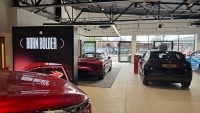When the government allows car dealers to go back to work there’s a good chance that home deliveries will become a part of business in the future.
Reports suggest the public strongly support the lockdown and are reluctant to get back out to work and life as normal for fear of catching and spreading coronavirus.
Many dealers are predicting that customers are unlikely to want to visit showrooms quite as freely as they did before and are investing in online sales solutions and home deliveries.
While the former certainly needs experts to help dealers set up their websites to cope, so too does the latter, as transporting and delivering a car safely isn’t all that simple.
Nationwide Vehicle Assistance’s Miles Keeble says the problem for many dealers is they simply won’t be set up for home deliveries.
He said: ‘Potentially losing control of a well-oiled traditional aftersales service and facing additional recruitment and training for drivers is likely to be challenging for dealers.
‘And that is coupled with the daunting prospect of the only face-to-face contact with the customer, being that of the delivery driver.’
The cost and training required might put dealers off – so the solution could be subcontracting the work out to experts.
‘Outsourcing the physical delivery of the vehicle can bring more sleepless nights, considering the potential risk to service and brand reputation,’ he added.
There are plenty of other things for a dealer to worry about. Many dealers need a home delivery service now – to allow them to get cars out the door and money in the bank.
Volvo boss Kristian Elverfors told us this weekend his dealers will be delivering cars to customers’ homes in a contactless way, but many of those retailers will need a solution now – and won’t want to buy transporters or train staff.
Here, Keeble offers his advice on what dealers can do to solve the problem.
What sort of costs should dealers be considering with deliveries?
There are a number of associated costs. There are the costs of owning a delivery truck or trucks. These are not limited to the cost of purchasing the metal itself.
Fuel and the cost of the driver are obvious additional expenses, but there are significant costs too when it comes to maintaining the vehicle and operating licence that is required to undertake these types of delivery.
If you have more than one truck, you’ll need a fleet manager too.
Aligning the technology to provide a world class customer experience is also key and a cost to consider. Can you track the delivery and give the customer online access, or make the photos of pre and post-delivery available to them via your own website?
Right now, of course, you need to consider the cost implication of the PPE and vehicle seat covers too. All reasons why investing in your own solution might not be a sensible idea.
What about sanitising – does that need to be considered?
Absolutely. Sanitise the vehicle and keys prior to loading the car on to a truck and use seat covers on the seats. Place the vehicle documents in a resealable bag.
At the customer’s home, call the customer to ensure they are in. Posting the keys through the letterbox is not sensible!
Wipe the vehicle again with anti-bacterial wipes (including the keys) and place the keys in a bag with the vehicle documents.
Take ‘delivery’ photos of the vehicle and this will assist with any damage disputes if they arise.
Knock on the door and move back at least two metres, acknowledge that the customer says who they say they are and ask for photo ID.
Once you are comfortable, advise the customer of such, let them shut the door and post the bag through.
How do you deal with a part exchange taken from a customers’ home that might not have been cleaned?
During the handover process, ask the customer to leave the documentation and keys on the step in an envelope or resealable bag. Ensure they you pick these up wearing disposable gloves.
It’s recommended that you avoid getting in the vehicle where possible. Ensure you have the correct truck to allow for ‘recovery’ of the part exchange and the vehicle can be ‘deep’ cleaned back at base. This is where professionals can certainly help as it’s unlikely your dealership will have the correct equipment.
Ensure you take pre and post loading pictures of the vehicle that can be shared with the customer once the vehicle has arrived back safely at the dealership.
Who do you think should pick up the cost of the delivery – the customer or dealer?
This is entirely down to the dealer and it’s a fine line between online purchasing being ‘just for now’ or a genuine long-term part of a dealers’ offering.
It’s likely, now, that a customer will be more willing to pay for a vehicle to be delivered. However, longer term, this has got to form part of a dealer experience that will provide them with a USP over competitors and at that point the dealer has to find a way of meeting the cost themselves or working that into a competitive deal.
Post Covid-19, a shiny new car arriving on the customer’s doorstep at 7pm, rather than them having to take time off work or get someone to look after the kids, may just be the difference between deal or no deal in the first place.
Will there be a shortage of drivers and trucks to deliver these cars?
Perhaps not a shortage, but there is likely to be plenty of demand, especially as other organisations like hire/lease companies and bodyshops consider similar types of vehicle movements.
The compliance process around owning and operating trucks is a complex one, so organisations that already operate in this way are likely to be in demand.
If a dealer chooses to get a staff member to deliver a car what should they tell them?
Wear the most appropriate level of personal protective equipment, probably limited to gloves right now, but keep an eye on the government guidelines around face masks as this advice looks likely to change as they lockdown rules relax.
From a personal hygiene perspective, they need to ensure that they are adhering to the guidelines around hand washing.
Will this generate a change in more home deliveries for customers in the future?
Almost certainly. Amazon has set the standard for home deliveries and kept time poor customers very happy.
Even for those customers that love the showroom experience, the delivery of the vehicle just seems to have a little more excitement about it, rather than the inconvenience of a collection.
Think of it as an exclusive event – a value add to the car buying experience!
Do you think customers will want to come back into dealerships any time soon?
Probably not, but getting customers to part with their money at all, will no doubt be the biggest challenge facing dealerships. That’s why the ability to provide an end-to-end online experience has to be part of their technological and operational road maps for dealers.
Does delivery work for all dealers – or is this just for the exclusive cars?
Any vehicle can be delivered, but one size doesn’t fit all. Delivery and online customer journeys have to be designed with the customer as the focal point.
Dealers do a fantastic job of brand promotion and brand loyalty, so there is little doubt that they ‘know their customer’ and will certainly design journeys that meet the differing needs of all of them. One thing is for sure, customers are very unlikely to want to leave home any time soon and home deliveries of cars might be the solution for some time yet.
Thanks for answering our questions – for those dealers that would like to use a third party like yours, what do they need to know about you?
We’re partners that understand the importance of maintaining a dealers’ brand values throughout the journey, especially when it comes to being the only face-to-face contact that customer might have.
We have collective experience of 100 years in vehicle movements, from collecting damaged cars for the country’s leading insurers and breakdown clubs to delivering prestige vehicles undercover to high net-worth clients.
- Thanks to Miles Keeble of Nationwide Vehicle Assistance for answering our questions. Find out more by clicking here or call 01621 735401.


































